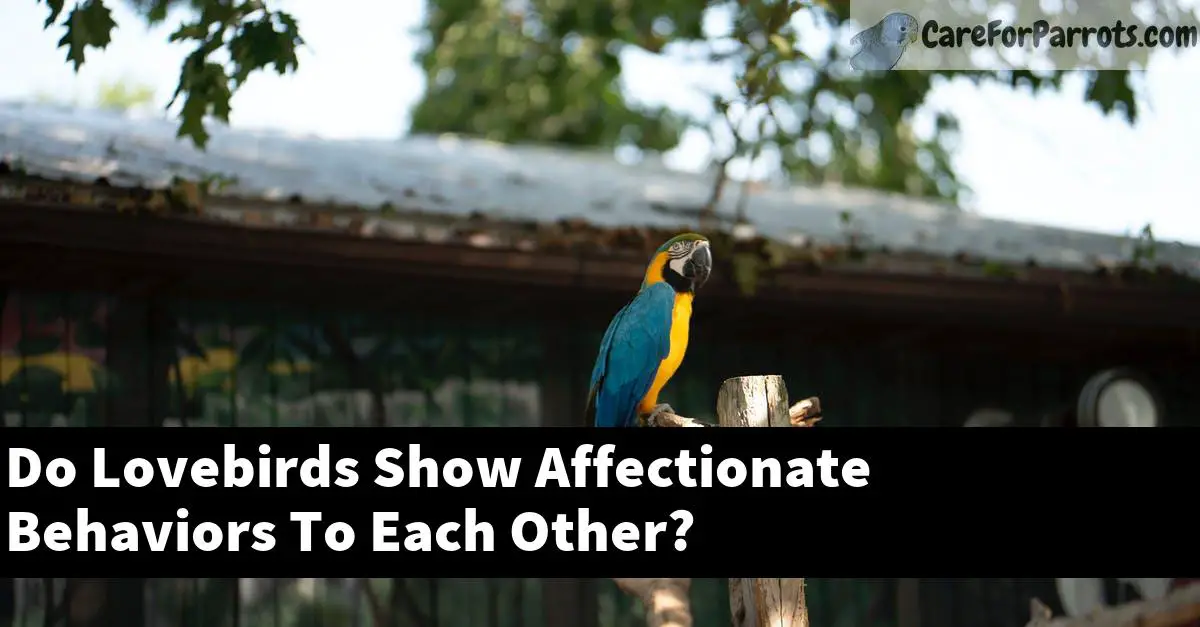Yes, lovebirds do show affectionate behaviors to each other. They may coo or sing to each other, or may gently nip at one another.
Table of Contents
What affectionate behaviors do lovebirds typically show to each other?
Lovebirds typically engage in a range of affectionate behaviors towards each other, including presenting their food to each other, preening each other, and cooing and chirping. They may also cuddle and nest together.
Do all lovebird species display affectionate behaviors in the same way?
There is no one-size-fits-all answer to this question as the behavior of lovebirds varies depending on the individual bird. However, many lovebirds do display a range of affectionate behaviors, including preening, nuzzling, and cuddling.
Some lovebirds may also engage in courtship behaviors, such as singing and dancing, in order to show their affection for one another. In some cases, lovebirds may also form monogamous relationships.
Regardless of the specific behaviors exhibited, all lovebirds likely show some level of affection towards their mates.
What might cause a lovebird to stop showing affection to its partner?
There can be a variety of reasons why a lovebird might stop showing affection to its partner, but the most common reasons are age-related and health-related. For example, a lovebird’s060 plumage may start to become dull or its feathers may become matted, which can make it difficult for the bird to fly and attract mates.
Additionally, as lovebirds get older, they may start to experience health problems, such as arthritis, which can make them less able to engage in physical activity and engage in social interactions. Finally, lovebirds may stop showing affection due to changes in their family structure, such as when one of the birds in the family dies or is no longer available to socialize with.
How can you tell if a lovebird is feeling particularly affectionate towards another bird or animal?
There are a few indicators that may suggest that a lovebird is feeling particularly affectionate towards another bird or animal. One way to determine this is to look for displays of physical affection, such as cuddling or shared preening.
Additionally, lovebirds may become noticeably more active and vocal when around their loved ones, often engaging in playful activities or singing together. Additionally, lovebirds may also exhibit changes in their plumage, such as brighter colors or more elaborate patterns.
Does the level of affection shown by lovebirds change over time?
There is no definitive answer to this question as it can vary from individual to individual. However, in general, lovebirds may become more affectionate as they get to know each other better.
Additionally, lovebirds may also display more affection when they are experiencing positive emotions, such as happiness or joy.
How does the amount of time spent together affect a lovebird’s ability to show affection?
There is a lot of research that has been conducted on this topic, and the general consensus is that the amount of time spent together does affect a lovebird’s ability to show affection.
One study found that lovebirds that were kept in captivity together for longer periods of time were less likely to engage in affectionate behaviors such as pecking, preening, and cuddling.
This was likely due to the fact that lovebirds are social animals and need to spend time with their mates to feel content and fulfilled.
Similarly, another study found that when pairs of lovebirds were kept in separate cages, the birds showed a decrease in mate preference and aggressive behavior.
This suggests that the birds were not content and were looking for ways to reconnect with their mates.
So, in general, it seems that the more time a lovebird spends with its mate, the more affectionate behaviors will be displayed.
However, it is important to note that each bird is unique and so the effects of being together may vary depending on the pair.
Can lovebirds show too much affection and what are the consequences of this behavior?
There can be many consequences to showing too much affection in a relationship, depending on the couple’s overall relationship dynamics and personality. If one partner is consistently showing too much affection, it can make the other feel neglected or like they’re not important to the other person.
This can lead to tension and conflict in the relationship.
Additionally, excessively demonstrative behavior can actually lead to problems in the relationship if one partner is not getting the same level of affection back.
This can cause the partner to feel insecure or left out, which can eventually lead to the breakup of the relationship.
Ultimately, it’s important to be mindful of how much affection is appropriate in any given relationship.
If one partner is excessively demonstrating their love, it may be best to scaled back or tone down their behavior.
Summary
Yes, lovebirds do show affectionate behaviors to each other. They may coo or sing to each other, or may gently nip at one another.






